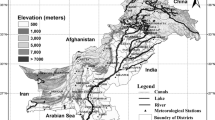Abstract
A drought index with respect to the spatio-temporal scale was developed in response to the demand from the agricultural sector in South Korea. The new drought index was calculated based on the soil water balance between the supply and demand of water. The water supply was estimated using the cumulative effective precipitation weighted by the precipitation from two months prior. The water demand was derived from the actual evapotranspiration, which was calculated by applying a crop coefficient to the reference evapotranspiration. The amount of surface runoff on a given soil type was used to calculate the residual soil moisture. The presence of drought was determined based on the probability distribution in the given area. In order to assess the reliability of this index, termed the Agricultural Drought Index (ADI), the amount of residual moisture, which represents the severity of a drought, was compared to the measurements of soil moisture at three experimental sites between July 2012 and December 2013. The results showed that the ADI had greater correlation with measured soil moisture than did the Standardized Precipitation Index (SPI), suggesting that the ADI is a useful indicator of drought. While both the SPI and ADI showed similar trends in the temporal variation of drought conditions at all of the sites, the ADI better detected ‘severe drought’ than did the SPI. The daily relief of severe drought due to precipitation was also better represented by the ADI. Using the high-resolution climatic and spatial data of a small watershed, we produced 270m resolution maps of ADI from week 36 through week 41 of 2013, demonstrating the feasibility of the ADI as an operational drought monitor appropriate for the agricultural environment of South Korea.
Similar content being viewed by others
References
Allen, R. G., L. S. Pereira, D. Raes, and M. Smith, 1998: Crop Evapotranspiration: Guidelines for Computing Crop Water Requirements. FAO irrigation and drainage paper 56, UN-FAO, Rome, Italy.
Byun, H. R., and D. A. Wilhite, 1999: Objective quantification of drought severity and duration. J. Climate, 12, 2747–2756.
FAO, 2013: AquaCrop. FAO, Rome. [Available at http://www.fao.org/nr/water/aquacrop.html]
Hayes, M., M. Svoboda, N. Wall, and M. Widhalm, 2011: The Lincoln declaration on drought indices: universal meteorological drought index recommended. Bull. Amer. Meteor. Soc, 92, 485–488.
Hillel, D., 1998: Environmental Soil Physics. Academic Press. 660 pp.
Idso, S. B., R. D. Jackson, P. J. Pinter, ffixJr., R. J. Reginato, and J. L. Hatfield, 1981: Normalizing the stress-degree day parameter for environmental variability. Agric. Meteor, 24, 45–55.
Kim, D. J., and J. I. Yun, 2013: Improving usage of the Korea Meteorological Administration’s digital forecasts in agriculture: 2. Refining the distribution of precipitation amount. Korean J. Agric. Forest Meteor, 15(3), 171–177, doi:10.5532/KJAFM.2013.15.3.171. (in Korean with English abstract)
McCuen, R. H., 1982: A Guide to Hydrologic Analysis Using SCS Methods. Prentice Hall, Englewood Cliffs, 110 p.
McKee, T. B., N. J. Doesken, and J. Kleist, 1993: The relationship of drought frequency and duration to time scale. In: Proceedings of the 8th Conference on Applied Climatology, Anaheim, CA, 17–22 January 1993. American Meteorological Society, 179–184.
Meyer, S. J., K. G. Hubbard, and D. A. Wilhite, 1993: A crop-specific drought index for corn: I. Model development and validation. Agron. J., 85, 396–399.
Morel-Seytoux, H. J., and J. P. Verdin, 1982: Correspondence between the SCS CN and Infiltration Parameters. In: Advances in Irrigation and Drainage: Surviving External Pressures, American Society of Civil Engineers, 308–319.
Narasimhan, B., and R. Srinivasan, 2005: Development and evaluation of soil moisture deficit index and evapotranspiration deficit index for agricultural drought monitoring. Agric. Forest Meteor., 133, 69–88, doi: 10.1016/j.agrformet.2005.07.012.
Palmer, W. C., 1965: Meteorological Drought. Research Paper No. 45. U.S. Weather Bureau. Washington, DC.
Palmer, W. C., 1968: Keeping track of moisture conditions, nationwide: The new crop moisture index. Weatherwise, 21, 156–161. doi:10.1080/00431672.1968.9932814.
Svoboda, M., M. Hayes, and D. Wood, 2012: Standardized Precipitation Index User Guide. WMO-No. 1090, World Meteorological Organization, Geneva. 16 p.
Trenberth, K., J. Overpeck, and S. Solomon, 2004: Exploring drought and its implications for the future. Eos, Transactions of American Geophysical Union, 85(3), 27–29.
Woli, P., J. W. Jones, K. T. Ingram, and C. W. Fraisse, 2012: Agricultural reference index for drought (ARID). Agron. J., 104(2), 287–300.
Yoo, S. H., J. Y. Choi, and M. W. Jang, 2006: Estimation of paddy rice crop coefficients for FAO Penman-Monteith and modified Penman Method. J. Korean Soc. Agric. Eng., 48(1), 13–23. (in Korean with English abstract)
Yun, J. I., S. O. Kim, J. H. Kim, and D. J. Kim, 2013: User-specific agrometeorological service to local farming community: a case study. Korean J. Agric. Forest Meteor., 15(4), 63–73, doi:10.5532/KJAFM.2013.15.4.320. (in Korean with English Abstract)
Author information
Authors and Affiliations
Corresponding author
Rights and permissions
About this article
Cite this article
Kim, DJ., Kim, SO., Kim, JH. et al. A drought index designed for field-scale water management. Asia-Pacific J Atmos Sci 51, 197–203 (2015). https://doi.org/10.1007/s13143-015-0070-9
Received:
Accepted:
Published:
Issue Date:
DOI: https://doi.org/10.1007/s13143-015-0070-9




